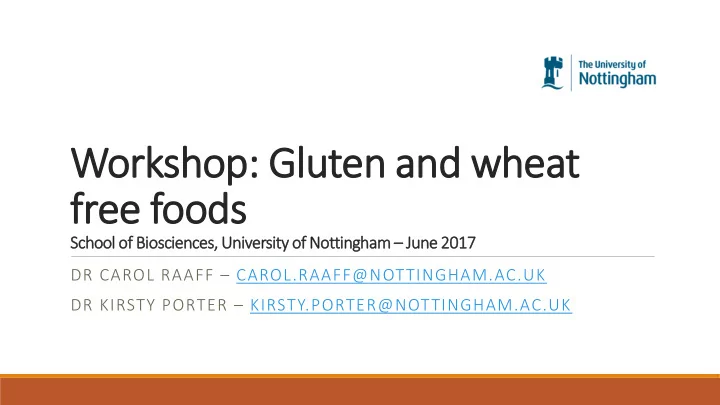

Workshop: Gluten and wheat free foods School of Biosciences, University of Nottingham – June 2017 DR CAROL RAAFF – CAROL.RAAFF@NOTTINGHAM.AC.UK DR KIRSTY PORTER – KIRSTY.PORTER@NOTTINGHAM.AC.UK
1. Reasons for people purchasing gluten free (GF) or wheat free (WF) products: coeliac disease, During the gluten intolerance and wheat intolerance/allergy session we will 2. Differences between gluten and wheat protein discuss: 3. Naturally occurring GF and WF alternatives, and manufactured versions 4. Nutritional considerations of removing gluten and wheat protein from the diet 5. Cross contamination 6. Food labelling 7. Useful resources and questions
1. Health halo effect: Why do people buy gluten (GF) or wheat free (WF) foods?
1. Health halo effect: 2. Improves symptoms: Why do people buy gluten (GF) 3. Clinical diagnosis: or wheat free - Gluten intolerance (WF) foods? - Coeliac disease - Wheat intolerance or allergy 4. Providing food for those following a GF or WF diet
Symptoms of people intolerant to gluten or wheat: May be immediate or delayed by hours or days Mild or severe
Symptoms of people intolerant to gluten or wheat: Coeliac disease: https://www.coeliac.org.uk/coeliac -disease/about-coeliac-disease-and- dermatitis-herpetiformis/ Wheat allergy/intolerance: https://www.nutrition.org.uk/nutri tionscience/allergy/wheat- May be immediate or intolerance-and-coeliac- delayed by hours or days disease.html
How many people Reaction to wheat: Reaction to gluten: • 1-2% of adults have a food have a clinical • Coeliac disease: incidence of 1 allergy and in 100 (Coeliac UK, 2017), reason for 5-8% of children (FSA, i.e. 650 000 2016), i.e. 2 million following a GF or • 24% who have the condition • UK hospital admissions for WF diet? have been diagnosed – nearly children with food allergies 500 000 have it but don’t increased by 700% since know yet 1990 • Non-coeliac gluten sensitivity? • Wheat intolerance? Estimated 3-6% population Estimated market: • UK FreeFrom market: 2015: £470m 2016: £531m 2020: £630m (Mintel) • > half (54%) of those who eat free from would stop eating these foods if they thought that they were less healthy • GF products on prescription – current situation
What is wheat protein and gluten? WHEAT: GLUTEN: Fibre B vitamins Some protein Carbohydrates B vitamins Protein Protein Some B vitamins Vitamin E
Foods that contain wheat and naturally WF foods WHEAT-CONTAINING: SOME NATURALLY WF FOODS: - Bread, breadcrumbs, wheat - Corn, maize, cornflour, barley, flour, wheat starch, wheat rye, oats, oatmeal germ, wheat protein, bran, rusk, cake, pastry, batter, - Buckwheat, arrowroot, gram biscuits flour, tapioca, sago - Cereal binder, raising agents - Rice, rice flour - Hydrolysed vegetable proteins, e.g. soya sauce - Lagers, beer and ale (check)
Examples of manufactured WF products
Food that contain gluten and naturally GF foods GLUTEN-CONTAINING: SOME NATURALLY GF FOODS: - Corn, maize, cornflour, buckwheat, Wheat arrowroot, gram flour, tapioca, sago, - Soya sauce - Liquorice quinoea - Batter - Lagers - Rice, rice flour, potato flour, gelatine Barley - Jelly, liquorice root - Barley malt extract - Cocoa, coffee, tea, ginger beer, squash - Barley waters and squash - Cider, liqueurs, port, sherry, spirits, wine - Malted milk drinks - (glucose syrups derived from wheat or - Ales, beers, stouts barley, incl. dextrose) Rye and Oats - (wheat based maltodextrins) - (distilled ingredients made from cereals that Spelt and Kamut (Khorasan wheat) contain gluten, e.g. alcoholic spirits)
Manufactured GF foods MANUFACTURED GF FOODS: GF FOOD LABELLING: Foods labelled as GF have to have ≤ 20 ppm GF: (Codex Alimentarius Standard, 2008) - Batters, breadcrumbs, Codex wheat starch: cakes, biscuits, bread, - Manufactured wheat starch that has been pastry, wafers, etc. processed to reduce the level of gluten to a - Bread mixes, flour level within the Codex standard - Oats - Improves quality and texture - Beers and lagers - Products which contain Codex wheat starch are not WF
Some examples of manufactured GF products
Nutritional Nutrients at risk: implications of - UK wheat flours are fortified removing gluten iron, B vitamins and calcium and wheat from - Wholemeal versions are the diet: exempt (FSA, 1998) - Dietary fibre - Potentially higher fat and higher sugar Fibre products B vitamins Carbohydrates B vitamins Some B Vitamin E vitamins
Cross contamination Staff training! In small groups, discuss potential sources of cross contamination for your area of food and/or drink production?
General rules: Food labelling • Labelling should highlight food allergens contained: for allergens in e.g. skimmed milk powder, whey ( milk ), lactose ( milk ), rusk , wheat flour general: • Above is required where foods are sold directly to customers or to mass caterers without packaging • Allergen information must be provided for non- prepacked foods in written or oral formats with clear signposting to where consumers can obtain this information (Annex II and Commission Delegated Regulation (EU) No. 78/2014 amending Annex II to Regulation (EU) No 1169/2011) (FSA)
Can use terms: ‘ Gluten- free’: 20 parts per million of gluten or less - - ‘Very low gluten’: 21 to 100 parts per million of gluten, but this can only be applied to foods with a cereal ingredient that has been processed to remove the gluten Labelling for GF - ‘Suitable for people intolerant to gluten’ or ‘suitable for foods coeliacs ’ Cannot use terms: - ‘No gluten containing ingredients’ or similar factual statements (Regulation (EU) 828/ 2014) (FSA, 2016) May contain statements: - May contain traces of gluten - Made on a line handling wheat - Made in a factory also handling wheat Guidance document: - Not suitable for people with coeliac disease/a wheat allergy due https://www.food.gov.uk/sites/d to manufacturing methods efault/files/gluten-guidance.pdf
Gluten-free product certification • Symbol can reassure customers • Used nationally and internationally by Coeliac organisations (incl. Coeliac UK) • Three categories of certification: UK, Europe and Global • Require product testing at least once annually using a UKAS or equivalently certified lab • European cert. also requires annual audit of production facilities For further information on cross grain symbol product certification: https://www.coeliac.org.uk/food-industry- professionals/the-crossed-grain-symbol/ For a list of UKAS-accredited testing labs: https://www.ukas.com/browes_accredited_organisations/?catshow=no&org_type=Testing%20Labs
Other useful information
Questions? carol.raaff@nottingham.ac.uk kirsty.porter@nottingham.ac.uk
Recommend
More recommend